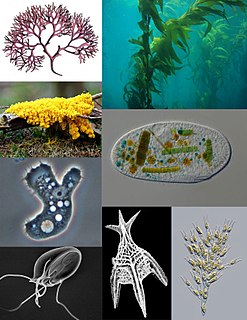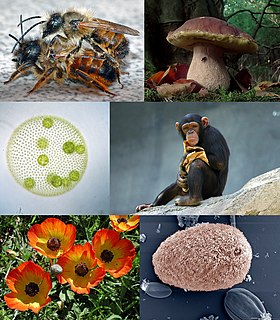This timeline of the evolutionary history of life represents the current scientific theory outlining the major events during the development of life on planet Earth. In biology, evolution is any change across successive generations in the heritable characteristics of biological populations. Evolutionary processes give rise to diversity at every level of biological organization, from kingdoms to species, and individual organisms and molecules, such as DNA and proteins. The similarities between all present day organisms indicate the presence of a common ancestor from which all known species, living and extinct, have diverged through the process of evolution. More than 99 percent of all species, amounting to over five billion species, that ever lived on Earth are estimated to be extinct. Estimates on the number of Earth's current species range from 10 million to 14 million, of which about 1.2 million have been documented and over 86 percent have not yet been described. However, a May 2016 scientific report estimates that 1 trillion species are currently on Earth, with only one-thousandth of one percent described.
In biology, kingdom is the second highest taxonomic rank, just below domain. Kingdoms are divided into smaller groups called phyla. Traditionally, some textbooks from the United States and Canada used a system of six kingdoms while textbooks in Great Britain, India, Greece, Brazil and other countries use five kingdoms only. Some recent classifications based on modern cladistics have explicitly abandoned the term kingdom, noting that the traditional kingdoms are not monophyletic, meaning that they do not consist of all the descendants of a common ancestor.

Excavata is a major supergroup of unicellular organisms belonging to the domain Eukaryota. It was first suggested by Simpson and Patterson in 1999 and introduced by Thomas Cavalier-Smith in 2002 as a formal taxon. It contains a variety of free-living and symbiotic forms, and also includes some important parasites of humans, including Giardia and Trichomonas. Excavates were formerly considered to be included in the now obsolete Protista kingdom. They are classified based on their flagellar structures, and they are considered to be the most basal Flagellate lineage. Phylogenomic analyses split the members of the Excavates into three different and not all closely related groups: Discobids, Metamonads and Malawimonads. Except for Euglenozoa, they are all non-photosynthetic.

The opisthokonts are a broad group of eukaryotes, including both the animal and fungus kingdoms. The opisthokonts, previously called the "Fungi/Metazoa group", are generally recognized as a clade. Opisthokonts together with Apusomonadida and Breviata comprise the larger clade Obazoa.

Chromalveolata was an eukaryote supergroup present in a major classification of 2005, then regarded as one of the six major groups within the eukaryotes. It was a refinement of the kingdom Chromista, first proposed by Thomas Cavalier-Smith in 1981. Chromalveolata was proposed to represent the organisms descended from a single secondary endosymbiosis involving a red alga and a bikont. The plastids in these organisms are those that contain chlorophyll c.
Telonemia is a phylum of microscopic eukaryote, single-celled organisms. They were formerly classified as protists until that kingdom fell out of general use, and are suggested to have evolutionary significance in being a possible transitional form between ecologically important heterotrophic and photosynthetic species among chromalveolates.

A protist is any eukaryotic organism that is not an animal, plant, or fungus. While it is likely that protists share a common ancestor, the exclusion of other eukaryotes means that protists do not form a natural group, or clade. So some protists may be more closely related to animals, plants, or fungi than they are to other protists; however, like algae, invertebrates, or protozoans, the grouping is used for convenience. The study of protists is termed protistology.

In biology, an organism is any individual contiguous system that embodies the properties of life. It is a synonym for "life form".

SAR or Harosa is a clade that includes stramenopiles (heterokonts), alveolates, and Rhizaria. The name is an acronym derived from the first letters of each of these clades; it has been alternatively spelled "RAS".

Eukaryotes are organisms whose cells have a nucleus enclosed within a nuclear envelope. Eukaryotes belong to the domain Eukaryota or Eukarya; their name comes from the Greek εὖ and κάρυον. The domain Eukaryota makes up one of the three domains of life; the prokaryotes Bacteria and Archaea make up the other two domains. The eukaryotes are usually now regarded as having emerged in the Archaea or as a sister of the now cultivated Asgard archaea. Eukaryotes represent a tiny minority of the number of organisms; however, due to their generally much larger size, their collective global biomass is estimated to be about equal to that of prokaryotes. Eukaryotes emerged approximately 2.1-1.6 billion years ago, during the Proterozoic eon, likely as flagellated phagotrophs.

Holomycota or Nucletmycea are a basal Opisthokont clade as sister of the Holozoa. It consists of the Cristidiscoidea and the kingdom Fungi. The position of nucleariids, unicellular free-living phagotrophic amoebae, as the earliest lineage of Holomycota suggests that animals and fungi independently acquired complex multicellularity from a common unicellular ancestor and that the osmotrophic lifestyle was originated later in the divergence of this eukaryotic lineage. Opisthosporidians is a recently proposed taxonomic group that includes aphelids, Microsporidia and Cryptomycota, three groups of endoparasites.

Alexandra (Alex) Z. Worden is a microbial ecologist and genome scientist known for her expertise in the ecology and evolution of ocean microbes and their influence on global biogeochemical cycles.
Rosemary Gillespie is an evolutionary biologist and professor of Environmental Science, Policy & Management, Division of Insect Biology at the University of California, Berkeley. She was the President of the American Genetics Association in 2018 and was previously President of the International Biogeography Society 2013–2015. From 2011 to 2013 she had served at the president of the American Arachnological Society. As of 2020 the faculty director of the Essig Museum of Entomology and a Professor and Schlinger Chair in systematic entomology at the University of California, Berkeley. She is known for her work on the evolution of communities on hotspot archipelagoes.
Choanozoa is a clade of opisthokont eukaryotes consisting of the choanoflagellates (Choanoflagellatea) and the animals. The sister-group relationship between the choanoflagellates and animals has important implications for the origin of the animals. The clade was identified in 2015 by Graham Budd and Sören Jensen, who used the name Apoikozoa. The 2018 revision of the classification first proposed by the International Society of Protistologists in 2012 recommends the use of the name Choanozoa.
Ruth Mace FBA is a British anthropologist, biologist, and academic. She specialises in the evolutionary ecology of human demography and life history, and phylogenetic approaches to culture and language evolution. Since 2004, she has been Professor of Evolutionary Anthropology at University College London.
Ruth Geyer Shaw is a professor and principal investigator in the Department of Ecology, Evolution and Behavior at the University of Minnesota. She studies the processes involved in genetic variation, specializing in plant population biology and evolutionary quantitative genetics. Her work is particularly relevant in studying the effects of stressors such as climate instability and population fragmentation on evolutionary change in populations. She has developed and applied new statistical methods for her field and is considered a leading population geneticist.
The Earth BioGenome Project (EBP) is an initiative that aims to sequence and catalog the genomes of all of Earth's currently described eukaryotic species over a period of ten years. The initiative would produce an open DNA database of biological information that provides a platform for scientific research and supports environmental and conservation initiatives. A scientific paper presenting the vision for the project was published in PNAS in April 2018, and the project officially launched November 1, 2018.

Christina Athena Aktipis is an associate professor in the Department of Psychology at Arizona State University. She is the director of the Interdisciplinary Cooperation Initiative and the co-director of the Human Generosity Project. She is also the director of the Cooperation and Conflict lab at Arizona State University, vice president of the International Society for Evolution, Ecology and Cancer (ISEEC), and was the director of human and social evolution and co-founder of the Center for Evolution and Cancer at UCSF. She is a cooperation theorist, an evolutionary biologist, an evolutionary psychologist, and a cancer biologist who works at the intersection of those fields. Aktipis is the author of the book published on March 24, 2020 from Princeton University Press The Cheating Cell: How Evolution Helps us Understand and Treat Cancer. Athena recently launched the second season of Zombified, a podcast created to communicate the science of zombification in daily life. Zombified is an extension of the Zombie Apocalypse Medicine Meeting (ZAMM), a biannual conference chaired by Aktipis. ZAMM is an interdisciplinary conference where art, science and medicine come together with the aim of solving complex issues.
Jeannine Cavender-Bares is a professor at the University of Minnesota in the Department of Ecology, Evolution & Behavior. Her research integrates evolutionary biology, ecology, and physiology by studying the functional traits of plants, with a particular focus on oaks.
Kayla C. King is Professor of Evolutionary Ecology at University of Oxford, specialising in how interactions between hosts and parasites show evolutionary change.









